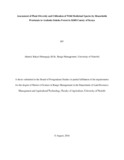| dc.description.abstract | Forests play fundamental roles in the provision of goods and services that are of utmost
importance for the subsistence and commercial needs of the rural communities worldwide.
However, there has been a reduction in the natural forest due to threats that are mainly attributed
to anthropogenic activities. The advent of climate change is likely to worsen the situation. The
pressure on forest resources is catalyzed by expansion of markets for forest products, agricultural
expansion and infrastructural development. For instance, an upsurge in the number of herbal
users in the urban and rural areas has increased the pressure on the forests, while modernization
and changes in lifestyle have led to loss of traditional knowledge on utilization and conservation
of forest resources. However, there is little empirical evidence on factors affecting knowledge
and the status of the utilized and marketed plant resources from the forest. This study was
therefore carried out in Arabuko Sokoke forest in Kilifi county of Kenya to determine plant
species diversity, and their distribution in the disturbed and undisturbed areas of the forest;
assess knowledge, utilization and contribution of medicinal plants to communities adjacent to the
Arabuko Sokoke Forest. The study also analysed marketing channels for the traded herbal
species and challenges in the trade. Plot and plotless techniques were used to gather ecological
data on frequency, density, diversity and distribution of plants in the Arabuko Sokoke forest,
whereas key informant interviews, focus group discussions and household interviews were used
to gather information on ethnobotanical knowledge and household socioeconomic data.
The highest plant species richness (78 species) and diversity (2.86±0.07) was recorded in the
mixed community as compared to the brachystegia and cynometra communities. This was
attributed to the favorable microclimatic and edaphic conditions in the mixed forest community.
Species diversity was significantly (P<0.05) higher in the disturbed areas (2.55±0.06 in cynometra
community and 2.86±0.07 in the mixed community) than in the undisturbed areas (2.25±0.07 in
cynometra community and 2.51±0.07 in the mixed community). The results also showed community). The results also showed a higher
number of woody plants with small diameter (4.0 to 33.9 cm), which depicts good generation
recruitment in the forest.
The results of the multiple regression model showed that age, use of herbal remedies, formal
education of the household head and households‘ engagement in agriculture as the chief source
of livelihood influenced the knowledge on medicinal plants. Anthropogenic factors such as
charcoal production and commercialization of herbal products contributed considerable threat to
medicinal plants. The results show that majority (71%) of households use plant medicine for
treatment of the common diseases. In addition to scarcity of some forest species and poor market
linkages, lack of proper processing and storage technologies, as well as value addition were
mentioned as the key challenges in herbal medicine trade. The results also show that most of the
traded plant products were obtained from the wild, and therefore pointing at the potential threat
to the resource base in the absence of appropriate conservation strategy.
From the results of this study, we recommend community awareness on sustainable forest
utilization. The study further recommends the preservation of ethnobotanical knowledge through
documentation and promotion of knowledge transmission to the youth. In addition, in situ
conservation, domestication of the rare marketed wild medicinal plants and enhancement of
market linkages is necessary to ensure maximum economic returns from herbal medicine trade.
Keywords: Medicinal plants; Use values; Knowledge on medicinal plants; Species diversity;
Trade of herbal products; Arabuko Sokoke forest | en_US |



